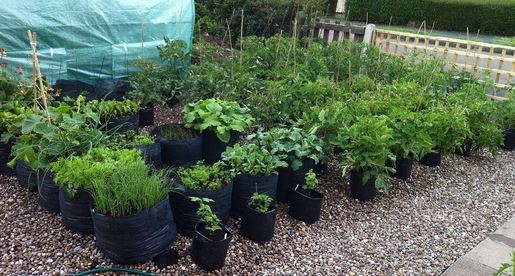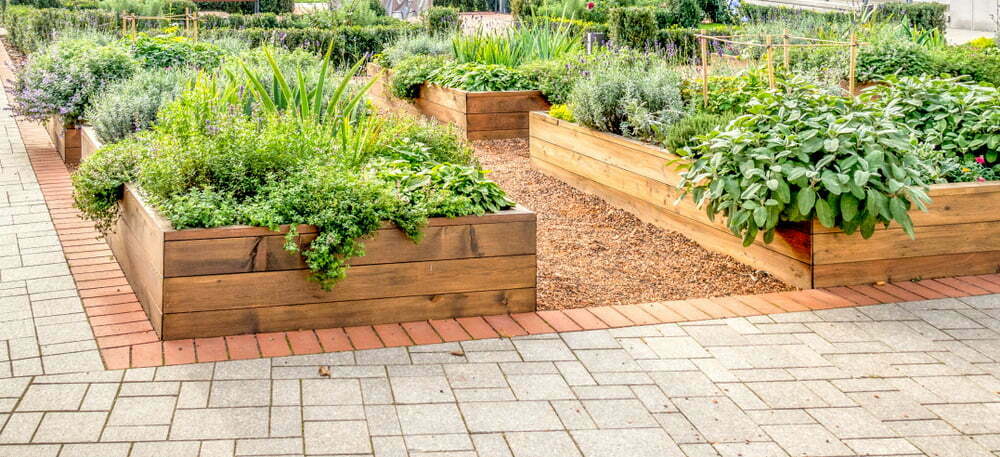In this Article
Growing vegetables in containers is a convenient, easy, and flexible way to have a garden. Container gardens are common in places where space is limited, such as apartments or small patios.
Which Crops Grow Best in Containers?
Container gardening is compatible with a wide array of crops, including tomatoes, herbs, lettuce, peppers, and smaller, bush varieties of cucumber and beans.
We do advise against growing crops that require abundant space and have large root systems that are incompatible with the limited area. Peppers and tomatoes are most suited to grow in pots, but even root crops such as carrots and beetroot seeds can be sown in deeper containers. Most vegetables are easy to grow from seeds in containers and the veg growing season can be extended somewhat if you have space to bring the pots or containers indoors at the end of the growing season.

When is the Best Time to Grow Vegetables in Containers?
While this answer can vary depending on the specific crop being grown, the ideal window of time to grow container vegetables can range from early spring to late autumn.
Pros of Container Gardening:
Containers Provide Mobility
Containers are mobile, which allows gardeners to be easily transported from place to place. This allows gardeners to take advantage of the best sunlight spots, or to protect your plants from inclement weather conditions.
It Saves Space
Containers are ideal for small-space gardens, such as patios, balconies, and windowsills. Container gardens are the perfect choice for those living in urban environments where in-ground gardening space is not so readily accessible.
Extended Growing Season
Container gardening allows for greater control over soil and air temperature, as well as light exposure. This allows gardeners to extend their growing season by several months.
Prior to the beginning of growing season, you can start your seedlings indoors. When the outdoor climate permits, your seedlings will be ready to be transferred to their larger pot.
Furthermore, as the growing season comes to a close, you can bring your pots indoors to give your vegetable garden a few more weeks of production by shielding it from the incoming frost.
Cons of Container Gardening:
Limited to Certain Varieties
Not every plant is compatible with a container lifestyle. Plants that take up a significant amount of space and have large root systems cannot be sustained in a container. Examples of such crops include melons, large varieties of cucumber, vine squash, and pole beans.
Requires Frequent Care
Because of the finite space in containers, both nutrients and water will deplete faster compared to in-ground counterparts. You’ll find yourself having to water and fertilize your plants more frequently.

What Should You Look for in a Container?
Drainage Holes
Drainage holes are essential in nearly every container; they help keep the soil moist but not waterlogged by giving the excess moisture a place to escape from. Without drainage holes at the bottom of your container, your plants are privy to fungal/bacterial diseases such as root rot.
Material
Some common container materials for a vegetable garden include plastic, fabric, or ceramic/terra cotta. Each one offers their own benefits and are suitable for a container vegetable garden.
Plastic pots are durable, inexpensive, and lightweight. Plastic pots retain water and therefore require drainage holes at the bottom. Because of their water retention, you’ll need to water less frequently compared to other materials.
Fabric is often used for grow bags. These are beneficial as they offer drainage and aeration for a healthy root system. Additionally, fabric bags are lightweight and foldable, which is perfect for storing them in small spaces.
Ceramic and terra cotta pots have a classic, rustic appearance that many gardeners find appealing. Similar to fabric grow bags, they are also porous and allow for airflow through the roots. This porous material also causes the ceramic to absorb more moisture, resulting in the soil drying out more often as opposed to plastic pots.

Care Tips for Containers
Choose a Soil with Drainage
When growing any plant in a container, it is essential to choose a soil with ample drainage. A well-draining soil will help prevent the soil from becoming compacted.
Compacted soil can make it difficult for roots to move through the soil with ease, resulting in stunted root growth. In addition, it makes it harder for water to pass through the soil; this causes trapped moisture to sit in the soil, which can harbor harmful bacteria and fungi.
This issue can be remedied by amending your soil with well-draining materials such as perlite or sand. These materials will break up compacted soil and make it easier for both roots and water to freely pass through the container.
Keep a Water Schedule
The limited container space, in addition to the increased drainage causes the soil to dry faster. As a result, you will find yourself needed to water your container plants more frequently.
A good rule of thumb is to wait until the first layer of soil has dried before rehydrating your plants. This will help maintain a good level of moisture; the soil is not too dry nor is it waterlogged.
Fertilize More Frequently
Similar to how moisture depletes at a faster rate, so does nutrients. You’ll find yourself needing to replenish your soil more often due to the finite resources.
We suggest applying a water-soluble fertilizer with a balanced NPK ratio. Follow the directions on the package and apply this fertilizer every 4 to 6 weeks through the growing season.
Resize When Necessary
Keep an eye out for signs that a plant has become root-bound. The most obvious sign of a root-bound plant is when the roots begin to grow out from the drainage holes.
Allowing a plant to live in this condition for an extended period of time can cause the plant’s growth to stifle. Stunted growth can be detrimental to the life of the plant and inhibit the plant’s ability to produce vegetables.
To repot your plant, select a new pot that is the next size up- no more than 5 to 8 cm larger in size. Gently loosen the tightly bound roots and repot the plant with fresh soil. Give your plant a thorough watering in order to reduce the stress of transplant shock.
Conclusion
Growing vegetables in containers may have some differences compared to an in-ground garden. But all in all, you’ll find that container gardening is fun, easy, and convenient!

